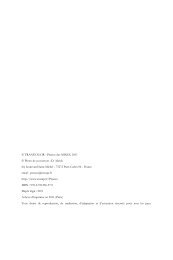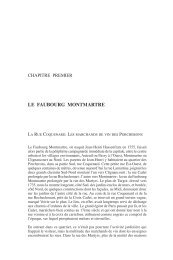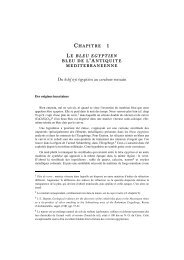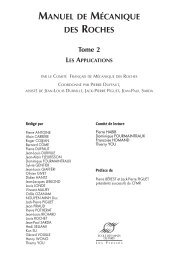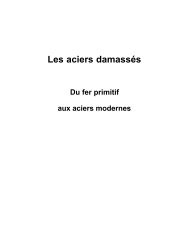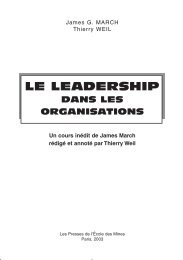Tribology of Manufacturing Processes - Presses des Mines
Tribology of Manufacturing Processes - Presses des Mines
Tribology of Manufacturing Processes - Presses des Mines
You also want an ePaper? Increase the reach of your titles
YUMPU automatically turns print PDFs into web optimized ePapers that Google loves.
4 th International Conference on <strong>Tribology</strong> in <strong>Manufacturing</strong> <strong>Processes</strong> - ICTMP 2010An emulsion is formulated and provided by a lubricant supplier as a mixture <strong>of</strong> base oil,typically 80-95% by volume, emulsifier, and a recipe <strong>of</strong> additives including brighteners,anti-foaming agents, bioci<strong>des</strong>, lubricity additives, etc. Deionized water is added by theend user and the mixture is agitated to form the emulsion.4.2 EXPERIMENTAL TESTING OF LUBRICANTS FOR ROLLING4.2.1 Cold rollingLaboratory scale rolling mills are needed for proper evaluation <strong>of</strong> lubricants [47-49].Such mills typically have a two-high or four-high configuration. Aside from qualitativeevaluation <strong>of</strong> anti-staining, antigalling and pickup prevention and the like, theseinstruments are applied for evaluation <strong>of</strong> friction and lubricity [50-52] and filmthickness [53], allowing inference <strong>of</strong> high pressure lubricant properties.Dubar et al. have developed an upsetting-rolling test for simulation <strong>of</strong> cold rolling tostudy the influence <strong>of</strong> rolling parameters like reduction, speed and tool temperature onfriction and lubricant film breakdown applying emulsions <strong>of</strong> mineral oil with additives<strong>of</strong> fatty acids, sulphur and phosphor compounds. They compared their results withexperiments in an industrial Sendzimir rolling mill and concluded that the combination<strong>of</strong> simulative testing with numerical modelling provided a good method for optimisation<strong>of</strong> industrial rolling parameters, [54-56].4.2.2 Hot rollingAzushima et al. have developed similar lubrication test stands for hot rolling as for coldrolling, [48,49]. Both test stands include a main stand performing the rolling and a substand delivering back tension causing a larger peripheral speed <strong>of</strong> the main roll than <strong>of</strong>the work piece to ensure skidding (neutral plane moved to the exit). The main stand isprovided with load cells and a torque transducer enabling determination <strong>of</strong> the averagecoefficient <strong>of</strong> friction μ during testing as: μ = M/PR, where M is the torque, P is the loadand R is the roll radius. As regards hot rolling an infrared furnace heating a strip withlength <strong>of</strong> 960 mm to a maximum temperature <strong>of</strong> 1100°C is located between the substand and the main stand. A comprehensive test program has been carried out studyingthe performance <strong>of</strong> a large number <strong>of</strong> lubricants based on five different base oils (seeTable 1) with various additives: Colza oil (vegetable oil based on the seeds <strong>of</strong> Brassicacampestris, Swedish turnips), mineral oils and synthetic ester oils with low as well ashigh viscosity. Additives investigated include oleic acid, fatty oil sulphide, graphite,MoS 2 and Mica, [57].The lubricants were tested in rolling 9 mm JIS SPHC (hot rolled, mild C-steel) at 800°Cwith a 0.3 mm thickness reduction. The peripheral speed <strong>of</strong> the main roll stand was 50m/min and the ratio between roll and strip velocity was 20. Figure 8 shows thecoefficient <strong>of</strong> friction as a function <strong>of</strong> the emulsion concentration for the three differentbase oils. The two lubricants with boundary lubrication effects give lower friction thanthe mineral oil, which does not have this effect. In all cases friction decreases withincreasing emulsion concentration up to 1% after which it reaches a constant value. Thisis explained by the change in lubrication mechanisms when changing from low to highemulsion concentration. At higher emulsion concentration effective separation <strong>of</strong> the14



